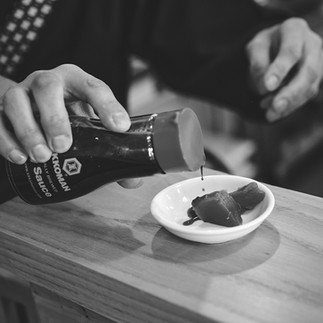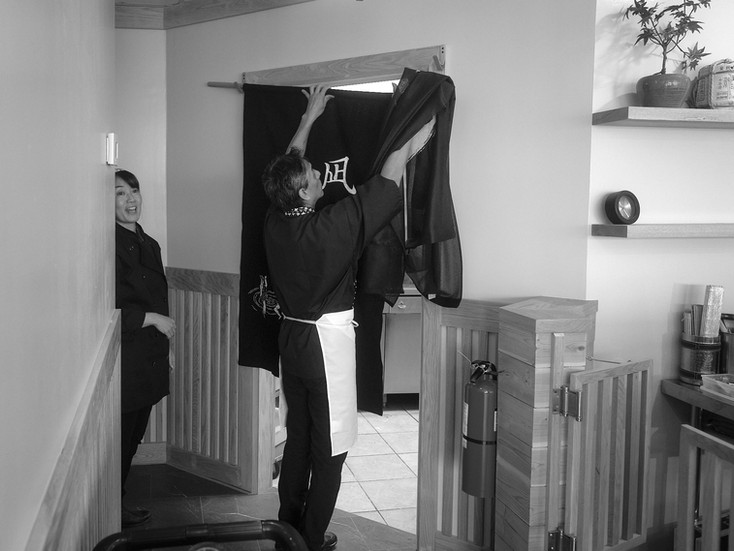It was a surprisingly brisk morning. Normally, this wouldn't be worth mentioning for Ottawa. But this winter was truly unusual, breaking weather records for its mildness and lack of snow.
So, as the snow slowly descended from the heavens on March 23, 2024, it was an unexpected and perhaps auspicious sign for the Grand Opening of Nagi Sushi.
At 8AM, Hiroha-san and Mina-san unlocked the door to Nagi Sushi. With a robotic female chirp of "Front door open" from the security console, the first day of business was officially underway. In three and a half hours, the restaurant would formally be open.
The Vision for Nagi Sushi
Create a space reminiscent of a typical Tokyo restaurant.
Create a space where customers can leave their worries at the door.
The simplicity of these design tenets provided to Eric Charonneau belied the complexity of Hiroha-san's vision for Nagi Sushi.
Nagi Sushi would be an entity, both physical and spiritual, curated by Hiroha-san to keep the origins, the atmosphere and ultimately the spirit of Japan alive for himself and for others. Recognizing that he was only a single link in a long chain of people with similar endeavours, he also wanted to ensure that Nagi Sushi would be a monument to those who came before but also those would come after. He saw his role as transitional, where he would pass the spirit, determination, and resolve of himself and everyone previous, to the next generation, in an effort to ensure that the spirit of Japan was kept alive.
A restaurant where he was both owner and chef would allow him to control every aspect of the dining experience, and Hiroha-san had a particular interest in the continued practice of omotenashi, a hospitality mindset generally summarized (and most likely oversimplified) as an encompassing mindfulness of the customer's well-being. During his thirty years at Suisha Gardens and C'est Japon à Suisha, he was always encouraged "To Serve and Cook with Hospitality," which would lead him to the the following revelation:
"Sushi is not just about technique and ingredients. It’s about the relationship with the customer. Taste is only 20% of sushi. Two different itamae might use the exact same ingredients, the same fish or the same rice. But it can be a different container, how you approach the customer, and how you serve it."
In other words, the relationship between the chef and the customer was the primary contributor towards customers' perception of his food and a more crucial factor than the aesthetics of the final plated dish or the provenance of any of its base components. With this realization, he would strive:
To be aware of the customer at all points throughout the dining experience; and
To emphasize to the customer that he is forever grateful for their patronage.
When asked how he would accomplish this, his answer was simple and yet, complex.
Smile and appreciate.
A series of pictures taken across two to three seconds of Hiroha-san shaping his nigiri sushi. Many itamae have said that the acts of shaping nigiri and handing nigiri to the customer are similar to a handshake. With each press of his hands, Hiroha-san's feelings of gratitude are transferred from his heart into the sushi. Thus, as he hands the sushi to you, he is giving you the feelings from his heart.
The Dining Space
Nine days ago, it was obvious that while there had been progress, there was still a significant amount of work remaining. Paint cans were stashed in a corner, tables were stacked to make space, and sawdust was everywhere. Today, the restaurant was spotless. And even then, a mop materialized in Mina-san's hands and she proceeded to wipe down the floor, erasing any trace of the infinitesimally small particles of dirt that may have tracked in from our shoes.
Immediately in front, stood a maneki-neko to welcome customers.
Six bamboo chairs in a matching colour palette stood alongside the now completed bar, awaiting the first customers of the day. Underneath the bar, hooks were installed allowing for small bags to be hung above the floor, rather than sitting on it.
Hiroha-san had placed various items with significant meaning above the bar.
Left: A rice paddle from Miyajima for good luck and a hand-carved fish from his daughter.
Right: In the middle stood a small pyramid of sake masu produced in the home prefecture of his grandmother, along with figurines of kirin, who are supposed to ward off evil.
A new entrance to the kitchen was built for a second access to the sushi bar. Above this entrance sat a kamidana, 神棚, that Haruka, one of Hiroha-san's partners, brought from the Ise Shrine in Japan. While there are many gods in Japan with their own divine jurisdictions, this particular god is fittingly the god of food.
A view of the sushi bar from the opposite direction and from a lower angle. A rice cooker was placed to Hiroha-san's right side, which is an interesting contrast to C'est Japon à Suisha where it was placed to his left. In the lower right of the first picture is a case containing Hiroha-san's sushi knives. The case was a present from Yamaguchi-san, the former head chef of the Ottawa branch of Suisha Gardens in the 1990s.

On the wall, a chalkboard had been erected with the first rendition of "Specials of the Day" written by Haruka. The specific combination of food for Shokado Bento Box were decided upon by Hiroha-san and Takako-san, the former head chef of C'est Japon à Suisha when it closed.
The Kitchen Space

In the kitchen, a calendar counting down to the last day was attached to the wall. Curiously, I don't remember seeing this calendar the last few times I was in the space.
Aside from some new kitchenware and being packed to the brim with ingredients, the kitchen hadn't significantly changed.
All the kitchenware had been washed and placed on newly installed shelving which, without an industrial dishwasher, had been strategically installed over the sink.

The ice machine was no longer in the middle of the room and had found a permanent home. Without a floor drain, it had to be elevated on a table to drain away any excess water courtesy of new plumbing along the lower wall.
More new shelving had been installed along the hallway immediately across from the second entrance with a variety of ingredients and dishware placed here for easy access. And hidden among the dishes was the second maneki-neko. True to his word, Hiroha-san had kept the local maneki-neko population to a minimum.
With cups of coffee in hand, Mina-san and Hiroha-san proceeded with the first of many thorough cleaning, which would continue throughout the day. Honestly, it felt like every time I caught Mina-san or Hiroha-san, they had just cleaned a surface or were about to clean a surface.
Once the first clean had been completed, it was time to soak the seaweed for the dashi, the basic building block of Japanese cuisine. The gentle heat slowly infused the flavour of the seaweed into the water, and brought the aroma of the sea throughout the restaurant. Mina-san would be asked to do a quick taste test.

As the morning progressed, more stocks and sauces were made, intermingling with the dashi and setting the stage for the day's flavours. Within these pots from left to right: tempura tsuyu, dashi for the miso soup and two pots of boiling water for edamame and to have extra hot water on hand.

Few words were spoken but every so often, light hearted bantering could be heard. "Wakkata, wakkata!" and then a loud exasperated sigh would resound throughout the restaurant but always with a hint of of a smile.
In my short time with Hiroha-san, I was used to seeing him don a serious mask in the restaurant so it was always interesting to see Mina-san maneuver around the mask and put a smile on his face.
For today's lunch service, Mina-san was in charge of the kitchen although she was supposed to be in charge of the book keeping. As she would wryly put it, she was not there permanently but just to help out for the first day. The goal was to find some people in the coming weeks.
Above: Mina-san had filled up the deep fryer and was frying some test pieces of tempura. Two lonely pieces sat there until she fed them to Hiroha-san later that morning.
For the Grand Opening, the Special of the Day was the Shokado Bento Box, an all-in-one box with chicken katsu, tempura, salad, fruit and dessert. With only Mina-san in the kitchen, she was prepping bento boxes in advance to mitigate the inevitable lunch and dinner rushes.
While there were a few openings for lunchtime, they were already booked solid for dinner.
Hiroha-san's Sushi
I once asked Hiroha-san if he considered himself a shokunin. The usual translation is "craftsperson" or "artisan" but there is a gravitas missing from the English translation underlining the importance of the term to the Japanese. To be shokunin is to be much more than a craftsperson. It is a title showing a commitment to the craft where the shokunin will continuously strive for perfection in all aspects. To be shokunin is to be a living example of dedication.
I had asked Hiroha-san this question knowing that he had been an itamae for 30 years.
With previous questions, Hiroha-san always continued whatever task he was in the middle of doing. But unexpectedly, his hands stopped and he turned his full attention to me. He listened respectfully, pondered his response and quietly but firmly said "No".
He paused again, as if to re-consider his words, and then elaborated further albeit in a soft-spoken manner that forced me to lean closer as I didn't want to miss or worse, misinterpret anything. In his opinion, the title of shokunin should only be granted by others, and not be self-proclaimed. And if someone declared him as a shokunin, although he would graciously thank them for the compliment, it was obvious in his demeanour that he did not think himself worthy of the title.
He would reinforce this self-effacing view when I asked him to describe his sushi:
“I just do standard sushi. Not super fine dining. I am the most bottom of the basic sushi. I want to be 0 meter. I make 0 in Ottawa. I am not standout in Ottawa. This is just basic sushi. Don’t want to do crazy technique. It’s why it’s named Nagi Sushi. Don’t need big waves.”
"My sushi balance is towards the shari. If shari is so nice, the neta doesn’t need to be so fancy. If shari is nice, then the sushi is tasty. Both are important. But I focus more on the rice."
Sushi rice is typically seasoned using rice vinegar, sugar and salt. But even with three ingredients, there is a myriad of different combinations and flavour profiles that can be created. The balance between these ingredients and the diametrically opposing tastes of sweetness and tartness is a personal decision for each itamae. Hiroha-san uses a combination of sugar, salt and vinegar through a recipe taught to him at Suisha Gardens thirty years ago. He still uses this recipe today.
First picture: Hiroha-san preparing another portion of sushi rice for the lunch service.
Second and third pictures: Hiroha-san using a rice paddle to perform shari-kiri, the act of gently separating and flipping clumps of rice to release excess moisture and mix in rice vingear and sugar. He would portion the rice into smaller containers that would be re-heated throughout the day.
The sushi station, prepped with the three knives that Hiroha-san will use to prepare sushi. The thinner long knife closest to the showcase is for slicing sashimi. The knife in the middle is for sashimi and to cut maki. The knife on the right is used for cutting more dense seafood such as shrimp shell, crab or fish head.
These knives were not made in Japan; but all the same, they were high quality steel. No matter the lineage, the knives were sharpened every day to ensure a sharp edge but also a sharp tip. According to Hiroha-san, the essence of the knife lies not in the edge, but the tip. If he ever dropped the knife, his first instinct would be to kick it gently, injuries be damned, to ensure the knife didn't fall tip-first onto the floor.
With the rice prepared, Hiroha-san crouched down behind the bar and started to pull out seafood from the fridges and arrange the showcase with the ingredients for the day.
Hiroha-san maintained that a showcase of the neta was necessary as it was easier to show the ingredients to people. But it was a future goal that as he grew more familiar with his new clientele, that he could remove the showcase to better converse with his customers.
From left to right, Hiroha-san had placed the following ingredients in the showcase: tamago, sake, aburi salmon, tako, hokk-gai (surf clam), ebi, hotate, ika, hamachi, more salmon, maguro, fresh wasabi, and uni.
Only a few more ingredients had to be prepped. Hiroha-san pulled out a large piece of bluefin tuna which was located across the neck, towards the back loin, and began to break it down, showing both the akami and chutoro, otherwise known as the lean and medium fatty cuts.
The next fish that Hiroha-san broke down was golden threadfin bream, otherwise known as itoyoridai. After, he carefully extracted the bones using tweezers.

Above: Grating ginger, a topping that would be used for saba and aji nigiri.
The Final Stretch
Throughout the day, deliverymen would step through the threshold carrying bouquets of flowers, a Japanese tradition called kaiten-iwai where flowers are sent to mark the opening of new businesses.
This noren was made by Mina-san's friend in Tokushima, Japan and miraculously arrived right before the opening day. It depicts the Awa Odori, a famous dance and festival from Tokushima and had been dyed a dark blue, using regional aizome dyeing techniques. In the Edo era, the noren was used to wipe one's hands upon leaving the restaurant. It was often said that a dirtier noren correlated with the tastiness of the food.
Eric Charbonneau had come in to work on some last minute functional improvements: a latch to keep the sushi bar swinging door open, and wire covers for wires that would clash against the wooden slats. Eric had been working with Hiroha-san for the better part of a year and the two had spent countless hours together looking at potential locations, designing the plans and working in the restaurant. Ultimately, this man is responsible for executing Hiroha-san's vision of Nagi Sushi.
Picture 2: Eric had tattooed a ruler onto his left forearm. Depending on how he flexed his arm, it was fairly accurate.
Haruka may be a familiar face for patrons of C'est Japon à Suisha who may have seen her behind the sushi bar assisting Hiroha-san.
While Hiroha-san has trained Haruka in sushi preparation, they state do not have a master-apprentice relationship but that they are fellow believers in the same omotenashi philosophy. She was a natural fit for Nagi Sushi and she was one of the first members that Hiroha-san confirmed for the team.

Kana, Hiroha-san and Mina-san's daughter, showed up at 10:30AM and immediately starting vacuuming the floor for its final clean before opening.
Above, Mina-san grabbing a picture of Kana (centre) and Haruka (right) with Nagi Sushi's menu, gleefully celebrating the first day.

And immediately afterwards, they were working the phones.

Mina-san, instructing Haruka and Kana on the service flow for the day.

Baylee (right) had just strolled into the restaurant as she was the server for the lunch shift.
In the lead-up to opening, someone noticed a pricing error on the menu. Haruka and Kana had to revise the menu, a laborious process of printing out stickers with the new price and placing it over the old price.
Final Touches

The first customer arrived at 11:15 and it was a familiar face, the leader of Oto-Wa Taiko who had performed at the last day of C'est Japon à Suisha.

As 11:30 approached, Eric plugged in the sign (another memoir from C'est Japon à Suisha) and Nagi Sushi was now "officially" open.
The Grand Opening was surprisingly quiet, with only one other customer arriving. I set my bags down at a table, became the third customer and had my customary order of chirashi-don.

One hour later, the place was hopping.
おめでとう Nagi Sushi!
Congratulations Nagi Sushi!








































































































































































































Comments